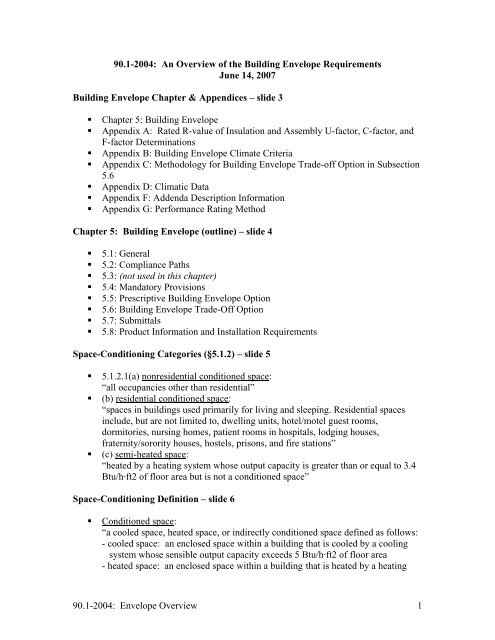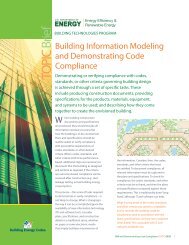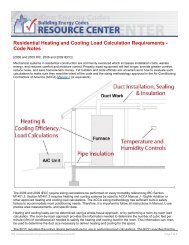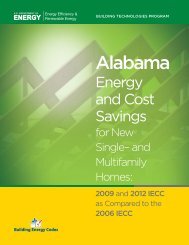Presentation Slides - Building Energy Codes
Presentation Slides - Building Energy Codes
Presentation Slides - Building Energy Codes
Create successful ePaper yourself
Turn your PDF publications into a flip-book with our unique Google optimized e-Paper software.
90.1-2004: An Overview of the <strong>Building</strong> Envelope RequirementsJune 14, 2007<strong>Building</strong> Envelope Chapter & Appendices – slide 3• Chapter 5: <strong>Building</strong> Envelope• Appendix A: Rated R-value of Insulation and Assembly U-factor, C-factor, andF-factor Determinations• Appendix B: <strong>Building</strong> Envelope Climate Criteria• Appendix C: Methodology for <strong>Building</strong> Envelope Trade-off Option in Subsection5.6• Appendix D: Climatic Data• Appendix F: Addenda Description Information• Appendix G: Performance Rating MethodChapter 5: <strong>Building</strong> Envelope (outline) – slide 4• 5.1: General• 5.2: Compliance Paths• 5.3: (not used in this chapter)• 5.4: Mandatory Provisions• 5.5: Prescriptive <strong>Building</strong> Envelope Option• 5.6: <strong>Building</strong> Envelope Trade-Off Option• 5.7: Submittals• 5.8: Product Information and Installation RequirementsSpace-Conditioning Categories (§5.1.2) – slide 5• 5.1.2.1(a) nonresidential conditioned space:“all occupancies other than residential”• (b) residential conditioned space:“spaces in buildings used primarily for living and sleeping. Residential spacesinclude, but are not limited to, dwelling units, hotel/motel guest rooms,dormitories, nursing homes, patient rooms in hospitals, lodging houses,fraternity/sorority houses, hostels, prisons, and fire stations”• (c) semi-heated space:“heated by a heating system whose output capacity is greater than or equal to 3.4Btu/h·ft2 of floor area but is not a conditioned space”Space-Conditioning Definition – slide 6• Conditioned space:“a cooled space, heated space, or indirectly conditioned space defined as follows:- cooled space: an enclosed space within a building that is cooled by a coolingsystem whose sensible output capacity exceeds 5 Btu/h·ft2 of floor area- heated space: an enclosed space within a building that is heated by a heating90.1-2004: Envelope Overview 1
system whose output capacity relative to the floor area is greater than or equal tothe criteria in Table 3.1”• Comment:- “conditioned” does not mean air-conditioned, it includes heated-only spaces- very few spaces qualify as semiheatedSpace-Conditioning Categories (§5.1.2) – slide 7• 5.1.2.2: Assumption of conditioned space:“Spaces shall be assumed to be conditioned space and shall comply with therequirements for conditioned space at the time of construction, regardless ofwhether mechanical or electrical equipment is included in the building permitapplication or installed at that time.”except “…if approved by the building official”• - meant to address problem of non-compliance in speculative buildings likewarehouses where owners want to pass cost to tenants and it is more expensive toinsulate later- example exception would be lumber storageClimate (§5.1.4) continued – slide 8• 5.1.4.1: United States locations:- Use Figure B-1 or Table B-1 in Appendix B to determine the requiredclimate zone (climate zones are specified by county)• 5.1.4.2: Canada and international locations:- For Canada, use Table B-2 in Appendix B,- For international, use Table B-3,- For locations not listed, use Table B-4• Later examples show the criteria for nonresidential uses in Climate Zone 5:Boston, Pittsburgh, Chicago, Omaha, Denver, Flagstaff, Reno, Vancouver BC.90.1-2004: Envelope Overview 2
Climate Zones and Climatic Data, Normative Appendices B and D – slide 9Figure B-1 and TableB-1 US Climate ZonesMandatory Provisions (§5.4) – slide 10• Insulation (§5.4.1, 5.8.1)to be discussed with Prescriptive Option• Fenestration and Doors (§5.4.2, 5.8.2)to be discussed with Prescriptive Option• Air Leakage (§5.4.3)• Note: Standard 90.1 and LEED require compliance with these mandatoryprovisions regardless of how energy-efficient the building is or how great theenergy savings are.Air Leakage (§5.4.3) – slide 11• <strong>Building</strong> Envelope Sealing (§5.4.3.1)- seal, caulk, gasket, weatherstrip all openings• Fenestration and Doors (§5.4.3.2)- air leakage < 1.0 cfm/ft2 for glazed swinging doors & revolving doors, < 0.4cfm/ft 2 for others• Loading Dock Weatherseals (§5.4.3.3)- in CZ 4-8 to limit leakage when truck parked90.1-2004: Envelope Overview 3
• Vestibules (§5.4.3.4)- for entrances in bldgs > 4 stories in CZ 3-8- exceptions for small spaces, revolving doors(Note: Criteria are more stringent in 90.1-2007.)Prescriptive Option (§5.5) – slide 12• Opaque assemblies (§5.5.3)- roofs (3 categories)- walls, above grade (4 categories)- walls, below grade (1 category)- floors (3 categories)- slab-on-grade floors (2 categories)- opaque doors (2 categories)• Fenestration (§5.5.4)- vertical glazing (2 categories)(4 different categories in 90.1-2007)- skylights (3 categories)Opaque Assemblies (§5.5.3) – slide 13• Two compliance options (§5.5.3)• R-value of insulation alone:“R-values of insulation for the thermal resistance of the added insulation inframing cavities and continuous insulation only”- does not include air films or building materials- sometimes only continuous insulation (ci)• U-factor, C-factor, or F-factor for the entire assembly:“The values … listed in Normative Appendix A shall be used to determinecompliance”90.1-2004: Envelope Overview 4
Opaque Assemblies (§5.5.3) – slide 14Opaque Roofs (§5.5.3.1) – slide 15• Roof w/ insulation above deck:“all insulation installed above (outside of) the roofstructure and continuous”2004: R-15 ci, U-0.0632007: R-20 ci, U-0.048• Comments:- insulation R-value is a minimum for all locations, not acceptable to “average”R-values for tapered insulation- assembly U-factors in Appendix A Table A2.2- exception allows reduction for cool roofOpaque Roofs (§5.5.3.1) – slide 16• Metal building roof:“metal, structural, weathering surface, no ventilatedcavity, steel framing members”• Comments:Climate Zone 5Climate Zone 52004: R-19, U-0.0652007: addendum underreview- exception to 5.8.1.2 allows metal building insulation to be compressed betweenroof skin and structure- assembly U-factors in Appendix A Table A2.3- exception allows reduction for cool roof90.1-2004: Envelope Overview 5
Opaque Roofs (§5.5.3.1) – slide 17Climate Zone 5• Attic and all other roofs:“all other roofs”2004: R-30, U-0.034• Comments:- 5.8.1.8 prohibits installing roof insulation onsuspended ceiling with removable ceiling tiles2007: R-38, U-0.027- 5.8.1.6 prohibits recessing light fixtures into insulation unless area is < 1%- 5.8.1.4 requires baffles around eave vents- assembly U-factors in Appendix A in TablesA2.4 for wood joists, A2.5 for steel joists- possible reduction for single-rafter roofsOpaque Walls Above Grade (§5.5.3.2) – slide 18• Wall above grade, mass:“with a heat capacity exceeding 7 Btu/ft2·°F or amaterial unit weight of 5 Btu/ft2·°F if < 120 lb/ft3”2004: R-7.6 ci, U-0.1232007: R-11.4 ci, U-0.090• Comments:- “ci” (§3.2 definitions) means insulation must be “continuous across all structuralmembers without thermal bridges other than fasteners”- if metal or wood studs, then must use U-factor- assembly U-factors in Appendix A Table A3.1A- heat capacity in A3.1B, A3.1C, option in A3.1DOpaque Walls Above Grade (§5.5.3.2) – slide 19• Wall above grade, metal building:“metal spanning members supported by steel structural”• Comments:- exception to 5.8.1.2 allows metal building insulation to be compressed betweenwall skin and structure- assembly U-factors in Appendix A Table A3.2Opaque Walls Above Grade (§5.5.3.2) – slide 20• Wall above grade, steel-framed:“typical steel stud walls and curtain wall systems”• Comments:- cavity insulation must also be accompanied bycontinuous insulation due to thermal bridging- assembly U-factors in Appendix A Table A3.3Climate Zone 5Climate Zone 52004: R-13, U-0.1132007: addendum underreviewClimate Zone 52004: R-13 + R-3.8 ci,U-0.0842007: R-13 + R-7.5 ci,U-0.064- Table A9.2B shows that R-13 insulation only achieves an effective R-6.0 inmetal studs(R-19 in 6” stud only achieves R-7.1)90.1-2004: Envelope Overview 6
Opaque Walls Above Grade (§5.5.3.2) – slide 21Climate Zone 5• Wall above grade, wood-framed:2004: R-13, U-0.089“all other wall types, including wood stud walls”• Comments:2007: R-13 + R-3.8 ci,- while wood studs perform better thermally than steel, U-0.064 continuous insulation isstill beneficial- assembly U-factors in Appendix A Table A3.4- compressing insulation reduces R-value, Table A9.4C shows that R-19insulation only has an effective R-13 when forced into 4” studsOpaque Walls Above Grade (§5.5.3.3) – slide 22• Wall below grade:“that portion of a wall …that is entirely below thefinish grade and in contact with the ground”2004: NR, C-1.1402007: R-7.5 ci, C-0.119• Comments:- insulation must be continuous across the wall- if metal or wood studs, then must use C-factor- assembly C-factors in Appendix A Table A4.2(C-factor does not include R-values for exterior or interior air films or for soil)Opaque Floors (§5.5.3.4) – slide 23Climate Zone 5• Mass floor:“with a heat capacity exceeding 7 Btu/ft 2·°F or a 2004: R-8.3 ci, U-0.087material unit weight of 5 Btu/ft 2·°F if < 120 lb/ft 3 ” 2007: R-10.4 ci, U-0.074• Comments:- waffle-slab floors shall be insulated either on the interior above the slab or on allexposed surfaces of the waffle (A5.2.2.3)- similar for concrete beams (A5.2.2.4)- assembly U-factors in Appendix A Table A5.2Opaque Floors (§5.5.3.4) – slide 24Climate Zone 5Climate Zone 5• Steel joist floors:2004: R-19, U-0.052“steel joist members supported by structural members”2007: R-30, U-0.038• Comments:- 5.8.1.5 requires floor insulation be installed“in substantial contact with the inside surface”- assembly U-factors in Appendix A Table A5.3- Table A9.2A shows that R-30 insulation only achieves an effective R-23.7 wheninstalled between metal framing 4 feet on center90.1-2004: Envelope Overview 7
Opaque Floors (§5.5.3.4) – slide 25• Wood framed and other floors:“all other floor types, including wood joist floors”• Comments:- 5.8.1.5 requires floor insulation have“supports no greater than 24 in. on center”- assembly U-factors in Appendix A Table A5.4Climate Zone 52004: R-30, U-0.0332007: sameOpaque Slab-on-Grade (§5.5.3.5) – slide 26Slab-on-grade floor:“a slab floor…in contact with the ground and that is either above grade or is < 24 in.below the final elevation of the nearest exterior grade”• Unheated slab-on-grade floor:“a slab-on-grade that is not a heated slab-on-grade floor”Climate Zone 52004: NR, F-0.7302007: same• Heated slab-on-grade floor:“a slab-on-grade with a heating source either within or below it”Climate Zone 52004: R-10 for 36 inchesF-0.8402007: R-15 for 24 inchesF-0.860Opaque Door (§5.5.3.6) – slide 27Door:“all operable opening areas (which are not fenestration) …including swinging and roll-updoors, fire doors, and access hatches. Doors…more than one-half glass are…fenestration.”• Swinging:“all operable opaque panels with hinges on one side and 2004: U-0.700opaque revolving doors”Climate Zone 52007: same• Non-swinging:“roll-up, sliding, and…doors that are not swinging doors”Climate Zone 52004: U-1.4502007: U-0.50090.1-2004: Envelope Overview 8
Fenestration (§5.5.4) – slide 2840.1-50.0% fixed -0.46 SHGC all -0.25 U fixed -0.46 SHGC all -0.25 U fixed -0.98 SHGC all -NRFenestration Definition (§3.2) – slide 29• Fenestration:“all areas (including the frames) in the building envelope that let in light,including windows, plastic panels, clerestories, skylights, glass doors that aremore than one-half glass, and glass block walls”• Comments:- if it is not insulated roof, wall, or floor, then it is fenestrationFenestration Ratings (§5.8.2) – slide 30• U-factor (§5.8.2.4)“U-factors shall be determined in accordance with NFRC 100.U-factors for skylights shall be determined for a slope of 20 degrees above thehorizontal.”• Comments:- ratings are for overall product including glass, sash, and frame (not center ofglass)- the overall product U-factor w/frame can be twice as high as the center-of-glassU-factor- higher U-factor for products at a slope90.1-2004: Envelope Overview 9
Fenestration Ratings (§5.8.2) – slide 31• NFRC 100- first published in 1991- certified by U.S. DOE as EPAct-compliant- specifies standard rating conditions and sizes for apples-to-apples comparison- includes all product types: glazed wall systems (i.e. curtainwalls/storefronts),sloped glazing, skylights, casement, awning, picture, slider, pivoted, swingingdoors, sliding doors, etc.- ratings are based on simulation, not testing (limited testing is done forvalidation)- further information at www.nfrc.orgFenestration Ratings (§5.8.2) – slide 32• Solar Heat Gain Coefficient (§5.8.2.5)“SHGC for the overall fenestration area shall be determined in accordance withNFRC 200.”• Exceptions to 5.8.2.5:(a) allowable to use shading coefficient (SC) for the center of the glass multipliedby 0.86 provided that SC is from a spectral data file determined in accordancewith NFRC 300Fenestration Ratings (§5.8.2) – slide 33• Exceptions to 5.8.2.5 (cont.):(b) allowable to use SHGC for the center of the glass (instead of for the overallproduct)• Comments:- using the exceptions does not give the full credit that the NFRC-certified SHGCdoes- though the SHGC for the frame is not zero(ranges from 0.11-0.14 for metal frames and from 0.02 to 0.07 forwood/vinyl/ fiberglass), the SHGC for the frame is almost-always lower than theSHGC for the glassFenestration Ratings (§5.8.2) – slide 34• Visible Light Transmittance (§5.8.2.6)“Visible light transmittance shall be determined in accordance with NFRC 200.”• Comments:- only necessary if using the EnvStd compliance option in §5.6- however, NFRC requires products to be rated for visible light transmittance aswell as U-factor and SHGC, so information available90.1-2004: Envelope Overview 10
- important for daylighting, can now find products with VT more than twice ashigh as SHGCFenestration Ratings (§5.8.2) – slide 35• Ratings (§5.8.2.1)“U-factor, solar heat gain coefficient (SHGC)… shall be determined by alaboratory accredited by a nationally recognized accreditation organization, suchas the National Fenestration Rating Council ”• - ratings done by a qualified, independent party(though software is helpful for designers and is used by manufacturers forproduct design)- Appendices A8.1 & A8.2 provide some limited default values for unlabeledproductsFenestration Ratings (§5.8.2) – slide 36• Labeling (§5.8.2.2-3)“All manufactured fenestration products shall have a permanent nameplate,installed by the manufacturer, listing the U-factor, solar heat gain coefficient(SHGC)”OR“…certification for the installed fenestration listing the U-factor, SHGC”• NFRC labeling for inspectors:- manufactured products, 4” x 4” label at factory- site-built products, 8-1/2” x 11” label certificateFenestration Labeling (§5.8.2) – slide 3790.1-2004: Envelope Overview 11
Fenestration Labeling (§5.8.2) – slide 38Fenestration General (§5.5.4.1) – slide 39• Calculation methodology:“Gross wall areas and gross roof areas shall be calculated separately for eachspace-conditioning category for the purposes of determining compliance.”• - for mixed-use buildings, must do separate calculations for nonresidential,residential, and semiheated spaces.- within these subcategories, an exception allows area-weighted averaging for U-factor, SHGC90.1-2004: Envelope Overview 12
Fenestration Area Definition (§3.2) – slide 40Fenestration area:“total area of the fenestration measured using the rough opening and including theglazing, sash, and frame. For doors where the glazed vision area is less than 50% of thedoor area, the fenestration area is the glazed vision area. For all other doors, thefenestration area is the door area.”• - must use rough opening, not glass areaFenestration Area Definition (§3.2) – slide 41• Vertical glazing:“all fenestration other than skylights”• Skylights:“a fenestration surface having a slope of less than 60 degrees from the horizontalplane. Other fenestration, even if mounted on the roof of a building, is consideredvertical fenestration”• - clerestories and roof monitors are considered vertical fenestrationFenestration Area (§5.5.4.2) – slide 42• Vertical:“total vertical fenestration area shall be less than50% of the gross wall area”• Skylights:“total skylight area shall be less than 5% of thegross roof area”• - exception allows up to 75% area for thestreet-side of street-level retail provided ithas projection factor (overhang) > 0.5Climate Zone 52004: 50% max.2007: 40% max.Climate Zone 52004: 5% max.2007: sameFenestration U-Factor (§5.5.4.3) – slide 43• Vertical, fixed (curtainwall):2004: all frame materials, < 40%2007: metal/other• Vertical, operable:2004: all frame materials, < 40%2007: metal/other• - for 2004, typically achieve with double-glazingwith a very-good low-emissivity coating- for 2007, also need thermal-break in the frameClimate Zone 52004: U-0.57 max.2007: U-0.45/0.35 max.Climate Zone 52004: U-0.67 max.2007: U-0.55/0.35 max.90.1-2004: Envelope Overview 13
Fenestration SHGC (§5.5.4.4) – slide 44• Vertical, north-oriented:2004: varies by area, 30-40%2007: same for all areasClimate Zone 52004: SHGC-0.49 max.2007: SHGC-0.40 max.Climate Zone 52004: SHGC-0.39 max.2007: SHGC-0.40 max.• Vertical, other-oriented:2004: varies by area, 30-40%2007: same for all areas• - exception allows credit for “each fenestration product shaded by permanentprojections that will last as long as the building itself”Fenestration U-Factor (§5.5.4.3) – slide 45• Skylight, glass with curb and plastic with curb:• Skylight, all materials without curb:• - skylights with curbs can have a surface area that isdouble the rough opening area- skylights without curbs are sloped glazing like curtainwallsbut higher heat loss due to slopeClimate Zone 52004: U-1.17/1.10 max.2007: sameClimate Zone 52004: U-0.69 max.2007: sameFenestration SHGC (§5.5.4.4) – slide 46• Skylight, glass with curb and plastic with curb:• Skylight, all materials without curb:• - glass skylights can achieve the same SHGC asvertical fenestration with same low-e coating- plastic skylights must use other technologies- for 2010, may require w/auto daylighting controlClimate Zone 52004: SHGC-0.39/0.622007: sameClimate Zone 52004: SHGC-0.39 max.2007: sameEnvStd Trade-Off Option (§5.6) – slide 47• More flexibility, but more work• Trade-offs limited to envelope components - no lighting or HVAC• Includes daylighting – need good VT• Methodology and assumptions in Appendix C• See Users Manual with EnvStd90.1-2004: Envelope Overview 14
More <strong>Building</strong> Envelope <strong>Energy</strong> Efficiency – slide 48• ASHRAE/IESNA Standard 90.1-2007:- requires increased insulation, better fenestration- to be published this summer• ASHRAE/USGBC/IESNA Standard 189P, Design for High-Performance Green<strong>Building</strong>s Except Low-Rise Residential <strong>Building</strong>s:- available for public review through July 9th- goal of 30% additional energy savings- requires increased insulation, better fenestration- addresses fenestration orientation, exterior shadingMore Information – slide 51• Standard 90.1-2004, the Users Manual, and more detailed training opportunitiesare available from:www.ashrae.org‣ More information on the standard and compliance tools available from:www.energycodes.gov90.1-2004: Envelope Overview 15
















